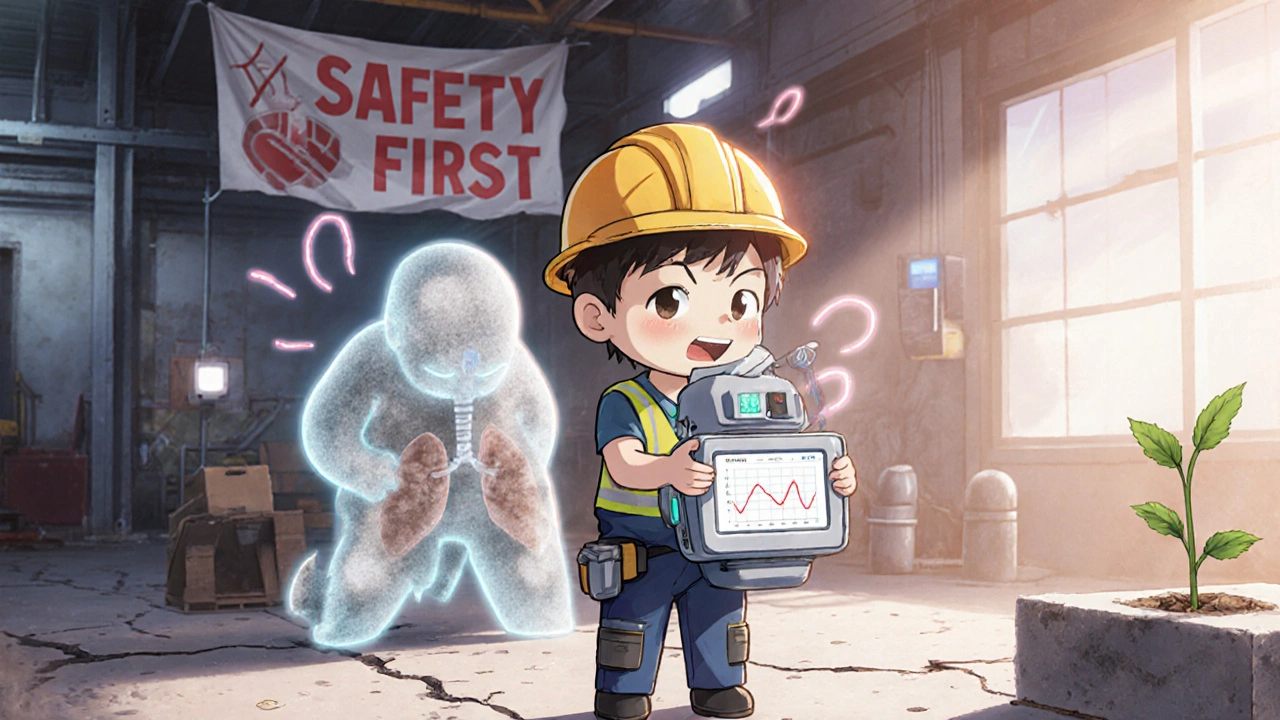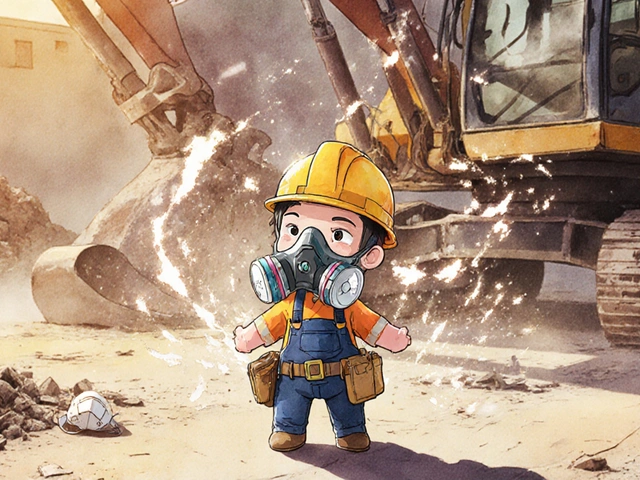Every year, more than 2,000 workers in the U.S. die from lung diseases caused by things they breathed in at work. Not from smoking. Not from pollution. But from dust and fibers they were never told could kill them. Silicosis and asbestosis aren’t rare relics of the past-they’re preventable tragedies happening right now, in construction sites, factories, and demolition crews across the country.
What Silicosis and Asbestosis Actually Do to Your Lungs
Silicosis comes from breathing in crystalline silica dust. It’s in sand, stone, concrete, and even some artificial countertops. When you cut, grind, or drill these materials without protection, invisible particles get deep into your lungs. Your body tries to fight them off, but instead of clearing them, it scars the tissue. Over time, your lungs stiffen. Breathing becomes harder. You cough more. Eventually, even walking to the mailbox feels like climbing a mountain.
Asbestosis is similar, but it’s caused by asbestos fibers-once used in insulation, roofing, pipes, and brake pads. These fibers are even thinner than silica dust and can stay in your lungs for decades. They don’t dissolve. They don’t leave. They just keep irritating, triggering inflammation, and slowly replacing healthy lung tissue with scar tissue. Both diseases are irreversible. Once the damage is done, there’s no cure.
People often think these diseases only affect miners or shipyard workers from the 1950s. But that’s not true. In 2023, the CDC reported over 1,200 deaths from silicosis in the U.S. alone. Asbestosis killed another 1,100 between 2004 and 2014. And those are just the confirmed cases. Many go undiagnosed because symptoms show up 10 to 30 years after exposure.
Why Prevention Works-And Why It Often Doesn’t
The scary part? Neither silicosis nor asbestosis should exist in 2025. We’ve had the tools to stop them for decades. The key is the hierarchy of controls: eliminate, substitute, engineer, administer, protect.
Elimination means removing the hazard. For example, using pre-cut stone instead of cutting it on-site. Substitution means swapping hazardous materials for safer ones-like using aluminum oxide instead of silica in abrasive blasting.
But most jobs still rely on engineering controls. That means using tools with built-in water sprays (wet cutting) to trap dust before it flies. Or installing local exhaust ventilation systems that pull contaminated air away from workers. These systems need to pull air at 100-150 feet per minute to work right. If they’re poorly installed or not maintained, they’re useless.
Administrative controls-like limiting exposure time or rotating workers-are helpful, but they’re not enough on their own. And then there’s PPE: respirators.
N-95 masks filter 95% of particles 0.3 microns in size. P-100s? 99.97%. Sounds good, right? But here’s the problem: workers don’t wear them right. A 2022 CDC report found that 68% of complaints about respirators were about discomfort or poor fit. In 90-degree heat, workers remove them. They tape them shut. They use old ones that don’t seal. One Reddit user in construction said, “I’ve been in demolition 15 years-never had a proper fit test until OSHA showed up.” That’s not an exception. It’s the norm.

What Really Stops These Diseases
Real prevention isn’t about posters on the wall or mandatory training videos. It’s about culture.
Companies that cut respiratory disease rates by 65% over three years didn’t just buy better equipment. They made safety a shared responsibility. Supervisors wore their respirators every single day-even when no one was watching. Workers were trained to speak up without fear. Fit tests happened every year, not just when OSHA showed up. Respirators were stored in clean, dry containers. And if someone complained about a mask hurting their face? They got a new one.
Small businesses struggle the most. In Wisconsin, 78% of companies with fewer than 20 workers didn’t have a full respiratory protection program in 2021. They can’t afford $5,000 ventilation systems. But they can afford wet cutting attachments for $200. They can afford to assign one person to check masks weekly. They can afford to let workers stop work if the dust is too thick.
And smoking? It makes everything worse. The American Lung Association says workers exposed to silica or asbestos who smoke have a 50-70% higher risk of developing lung disease. Quitting smoking isn’t just good for your health-it’s a job safety issue.
Who’s Being Protected-and Who Isn’t
Construction, mining, and manufacturing account for 75% of occupational lung disease cases. But the risk isn’t evenly spread. Roofers cutting old shingles. Tile installers grinding stone. Mechanics replacing brake pads. Landscapers using sandblasting equipment. These aren’t high-risk jobs on paper-they’re everyday tasks.
OSHA’s 2016 Silica Standard was supposed to fix this. It set a new exposure limit and required wet cutting, ventilation, and medical exams. But in 2021, OSHA cited over 1,000 construction companies for silica violations-$3.2 million in fines. That’s not enforcement. That’s damage control.
Asbestos is even trickier. The EPA estimates 733,000 public buildings in the U.S. still have asbestos in them. Schools, libraries, old factories. When renovations happen without proper abatement, workers and even students are at risk. And there’s no safe level of asbestos exposure. Not one fiber. That’s why the European Union is tightening limits again by 2025.

What You Can Do-Even If You’re Not a Boss
You don’t need a title to protect yourself. If you’re working with concrete, stone, or old insulation:
- Ask for wet cutting or local exhaust ventilation. If they say no, ask why.
- Request a fit test for your respirator. If they don’t offer one, ask for one. It’s the law.
- Never reuse a respirator that’s dirty, damaged, or smells like dust.
- Report unsafe conditions. OSHA’s whistleblower program protects you.
- Get a baseline spirometry test. Then get one every five years. If you’ve been exposed for years, ask for annual tests.
And if you’re in a leadership role? Don’t wait for OSHA to show up. Start with one thing: make sure every worker has a properly fitted P-100 respirator-and that they’re trained to use it. Then check in. Ask how it feels. Fix the problems. Reward people who speak up. Safety isn’t a checklist. It’s a habit.
The Future Is Already Here
NIOSH launched its Prevent eTool in 2023-a free digital guide for 15 high-risk industries. Companies using it saw a 40% drop in respiratory incidents within six months. Wearable sensors that alert workers in real-time when dust levels spike are now available for under $300. These aren’t science fiction. They’re tools you can use today.
The European Respiratory Society wants to eliminate occupational lung diseases by 2030. Germany’s pilot programs cut new cases by 55% with mandatory health monitoring. The U.S. could do the same. But it won’t happen by accident. It takes consistent enforcement, better technology, and a shift in mindset: worker health isn’t a cost. It’s the foundation of a good job.
These diseases don’t have to be part of the job description. They never did.
Can you get silicosis from one-time exposure to silica dust?
No, silicosis typically develops after years of repeated exposure. But acute silicosis can occur after just a few months of very high exposure-like sandblasting without protection. Even short-term exposure can cause lung irritation and increase long-term risk, so no exposure is safe.
Is asbestosis the same as mesothelioma?
No. Asbestosis is scarring of lung tissue from asbestos fibers. Mesothelioma is a rare, aggressive cancer of the lining of the lungs, heart, or abdomen. Both are caused by asbestos, but they’re different diseases. Mesothelioma has no cure. Asbestosis can be managed but not reversed.
Are N-95 masks enough for silica or asbestos?
N-95 masks filter 95% of particles, but they’re not designed for high-risk tasks like cutting concrete or removing asbestos. P-100 respirators are recommended because they filter 99.97% of particles and are oil-resistant. OSHA requires P-100s for asbestos abatement and high-exposure silica tasks.
How often should workers get lung function tests?
Workers exposed to silica or asbestos should get a baseline spirometry test before starting the job. After that, testing every five years is standard. But if they’ve been exposed for more than 10 years, or have symptoms like shortness of breath, annual testing is recommended to catch early decline.
Can you still work if you have silicosis or asbestosis?
Yes, but you must stop exposure immediately. Continuing to breathe in silica or asbestos will make the disease worse faster. Many workers switch to less hazardous roles or retire early. Medical management, including oxygen therapy and pulmonary rehab, can help maintain quality of life.
What’s the best way to clean up silica dust after a job?
Never sweep or use compressed air-it sends dust back into the air. Use a HEPA-filter vacuum designed for hazardous dust. Wet-wipe surfaces. Dispose of waste in sealed bags labeled for hazardous materials. Always wear a P-100 respirator during cleanup.
Do home DIY projects put me at risk?
Yes. Cutting concrete pavers, grinding tile, or sanding old paint can release silica or asbestos fibers. Use water, wear a P-100 mask, and ventilate the area. If you’re renovating a home built before 1980, assume asbestos is present. Get it tested before starting work.



